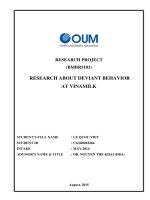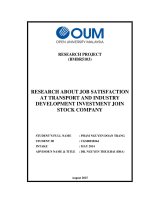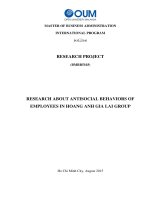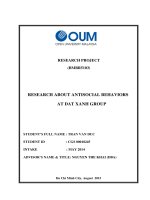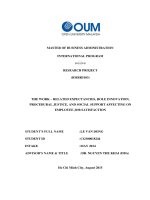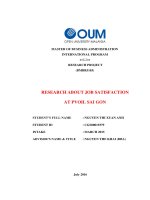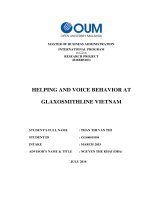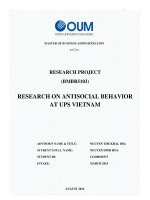Research about deviant behaviors at vinacafe (vietnam)
Bạn đang xem bản rút gọn của tài liệu. Xem và tải ngay bản đầy đủ của tài liệu tại đây (1.07 MB, 58 trang )
MASTER OF BUSINESS ADMINISTRATION
INTERNATIONAL PROGRAM
RESEARCH PROJECT
(BMBR5103)
RESEARCH ABOUT DEVIANT BEHAVIORS
AT VINACAFE (VIETNAM)
STUDENT’S FULL NAME
: VO THI THANH TAM
STUDENT ID
: CGS00019371
INTAKE
: MARCH 2015
ADVISOR’S NAME & TITLE : DR. KHAI NGUYEN
Ho Chi Minh City, July 2016
BUSINESS RESEARCH METHODS
ADVISOR’S ASSESSMENT
--------------------------------------------------------------------------------------------------------------------------------------------------------------------------------------------------------------------------------------------------------------------------------------------------------------------------------------------------------------------------------------------------------------------------------------------------------------------------------------------------------------------------------------------------------------------------------------------------------------------------------------------------------------------------------------------------------------------------------------------------------------------------------------------------------------------------------------------------------------------------------------------------------------------------------------------------------------------------------------------------------------------------------------------------------------------------------------------------------------------------------------------------------------------------------------------------------------------------------------------------------------------------------------------------------------------------------------------------------------------------------------
ADVISOR’S SIGNATURE
(July 2016)
NGUYEN THE KHAI (DBA)
Page 2
Vo Thi Thanh Tam (ID19371)
NGUYEN THE KHAI (DBA)
BUSINESS RESEARCH METHODS
TABLE OF CONTENTS
ACKNOWLEDGMENTS ..................................................................................... 6
ABSTRACT ............................................................................................................ 7
PART ONE: INTRODUCTION........................................................................... 8
Introduction VINACAFE ...................................................................................... 8
The formation and development of the Corporation Vietnam Coffee ................. 8
Enterprises participating in supply - Export ......................................................... 9
Capacity Analysis coffee export business of VINACAFE. ............................... 10
Organization structure and corporate culture ..................................................... 11
Mix organizational structure .......................................................................... 11
Corporate culture ............................................................................................ 11
Research problem statement ........................................................................... 13
Research objectives ......................................................................................... 13
Research scope ................................................................................................ 14
Significance of research .................................................................................. 14
PART TWO: LITERATURE REVIEW ........................................................... 15
Definition of Constructs ...................................................................................... 15
Deviant Behaviors .............................................................................................. 15
Job Overload ....................................................................................................... 16
Frustration With Work ....................................................................................... 17
Role Conflict and Ambiguity ............................................................................. 20
Work - Family Conflict ...................................................................................... 21
Hypotheses ............................................................................................................ 24
PART THREE: METHODS ............................................................................... 26
Data collection ...................................................................................................... 26
Vo Thi Thanh Tam (ID19371)
Page 3
BUSINESS RESEARCH METHODS
Design template scale ......................................................................................... 26
Data collection progress ..................................................................................... 37
Data analysis ......................................................................................................... 37
PART FOUR: RESULTS .................................................................................... 38
Cronbach’s Alpha ................................................................................................ 38
Cronbach’s Alpha standard applied.................................................................... 38
Cronbach’s Alpha of constructs ......................................................................... 38
Statistics information ........................................................................................... 40
Descriptive statistics ........................................................................................... 40
Correlation statistics ........................................................................................... 40
Hypotheses testing ................................................................................................ 41
Hypothesis proposed (H1) .................................................................................. 42
Hypothesis proposed (H2) .................................................................................. 42
Hypothesis proposed (H3) .................................................................................. 43
Hypothesis proposed (H4) .................................................................................. 43
PART FIVE: CONCLUSIONS .......................................................................... 44
REFERENCES ..................................................................................................... 46
SURVEY ............................................................................................................... 49
PRESENTATION ................................................................................................ 54
Vo Thi Thanh Tam (ID19371)
Page 4
BUSINESS RESEARCH METHODS
LIST OF TABLE
(Figure 1: Chart of the orgnization of VINACAFE) .............................................. 11
(Figure 2. Research model) ................................................................................... 25
(Table 1: Deviant Behaviors) ................................................................................ 28
(Table 2: Job Overload)......................................................................................... 30
(Table 3: Frustratio With Work) ............................................................................ 31
(Table 4: Rolr Conflict and Ambiguity) ................................................................. 34
(Table 5: Work-Family Conflict) ........................................................................... 36
(Table 6: Time table for data collection progress) ................................................ 37
(Table 7: Cronbach’s Alpha - Internal Consistency) ............................................ 38
(Table 8: Cronbach’s Alpha of Deviant Behaviors) .............................................. 38
(Table 9: Cronbach’s Alpha of Job Overload) ...................................................... 39
(Table 10: Cronbach’s Alpha of Frustration With Work) ..................................... 39
(Table 11: Cronbach’s Alpha of Role Conflict and Ambiguity) ............................ 39
(Table 12: Cronbach’s Alpha of Work-Family Conflict) ...................................... 40
(Table 13: Descriptive statistics) ........................................................................... 40
(Table 14: Correlation statistics) .......................................................................... 41
(Table 15: Model Summary) .................................................................................. 42
(Table 16: Coefficients) ......................................................................................... 42
Vo Thi Thanh Tam (ID19371)
Page 5
BUSINESS RESEARCH METHODS
ACKNOWLEDGMENTS
This research was supported by my lecturer is Mr. Khai Nguyen who offers
many valid comments.
Thank you so much to employees of VINACAFE, they are offer valid
information help me to complete this study.
And the last, I am grateful to my family, colleagues, and my friends who
stand side by side and supported me a lot.
Vo Thi Thanh Tam student
Vo Thi Thanh Tam (ID19371)
Page 6
BUSINESS RESEARCH METHODS
ABSTRACT
This purpose of this research is way to find the factors influence to Deviant
Behaviors of employees working at VINACAFE.
This research project will use Business Research Methods to determine
Deviant Behaviors and what other main factors that it influence job satisfaction.
And this research also was conducted by quantitative method with source data is
surveys that it issued by offline to 500 employees of VINACAFE to collect the
ideas and comments of employees about deviant behaviors.
Next, the result of these surveys shall be statistically analyzed by software
SPSS version 22 (copyright of IBM). Hypotheses used this research includes five
constructs: one dependent construct (Deviant Behaviors) and four independent
constructs (Job Overload, Frustration With Work, Role Conflict and Ambiguity,
Work-Family Conflict )
I hope results of this research will help the CEO; managers of VINACAFE
have some reference angle in human resource management to improve and
increase our quality resource based on deviant behaviors of employees as well as
you should have perception clearly that deviant behaviors of employees will
impact to working effective, ability of competitiveness of the company on real
market.
Vo Thi Thanh Tam (ID19371)
Page 7
BUSINESS RESEARCH METHODS
PART ONE: INTRODUCTION
Introduction VINACAFE
The formation and development of the Corporation Vietnam Coffee
Coffee Corporation Vietnam international transaction name is VIETNAM
NATIONAL COFFEE CORPORATION (abbreviated as VINACAFE) was
established under Decision No. 251 / TTg dated 29/04/1995 of the Prime Minister
and operates on the the regulations issued with Decision No 44-CP dated
15/07/1995 of the Prime Minister. VINACAFE predecessor of the Union of
Vietnam coffee factory, founded on 10.13.1982 by Decision 174 / HĐBT of
President of the Council of Ministers (now the Prime Minister).
VINACAFE has about 37,000 hectares of land in the Central Highlands
coffee growers. Of the 57 members, there are 40 units VINACAFE agricultural
production, with 4 units of large import-export business, 5 processing factories
high quality coffee beans processing plant and 1 instant coffee Large best of
Vietnam - VINACAFE 'Bien Hoa.
Vo Thi Thanh Tam (ID19371)
Page 8
BUSINESS RESEARCH METHODS
Enterprises participating in supply - Export
Most of the units in operation in the field VINACAFE coffee are coffee
suppliers. Either grow supply or collected from other growers to supply on the
market or supply to the units in VINACAFE.
The wholesale purchase and export coffee VINACAFE:
- Vinacafé Bien Hoa Joint Stock Co.
- THE HANDS NGUYEN COFFEE INVESTMENT IMPORT - EXPORT
JOINT STOCK
- Company Material Supply Coffee Processing Export (Macopex)
- Coffee Company Iasao
Lines of business Vinacafe include:
Investments, investment management and direct production, sales in the lines, key
areas are:
- Cultivation, production and business Coffee, cocoa, rubber, pepper, cashew,
sugarcane, tea, food plants and other industrial plants; forestry, mining and
forestry, forest products and related services; rearing, fishing, marine and related
services.
- Investment in the industrial processing of agricultural products: Coffee, tea,
rubber, cocoa, pepper, sugar, honey ....
- Production and trading of fertilizers and materials, consumer goods for
production and daily life.
- Animal breeding, production and processing of animal feed, food processing.
- Construction of traffic works, irrigation, reclamation, management, use and
exploitation of irrigation and hydropower.
- Training and technology transfer related to the cultivation, production and
processing of coffee and other agricultural goods, forestry and aquatic products;
consultancy, providing labor exports.
Vo Thi Thanh Tam (ID19371)
Page 9
BUSINESS RESEARCH METHODS
- Investments in equity of subsidiaries, joint-stock companies, limited liability
companies and other companies operating under the provisions of law.
Purpose, mission and strategy
Enhancing the standards of food safety.
Hold 1st place in Vietnam in the coffee industry and successful
participation in the new sectors.
Vinacafe brand will be widely available in key markets abroad as the US,
ASEAN, North-East Asia, China and Eastern Europe.
The main task of the Corporation VINACAFE is nuclear ensure
agricultural production, mainly on seeds.
Capacity Analysis coffee export business of VINACAFE.
Human Resources
Total workforce: 21,900 people, including:
- Public employee social insurance contributions: 15 160 people
- Workers venture, links social insurance contributions: 4,040
people
- Workers seasonal labor contracts: 2,700
- Workers contracted orchards contract: 15 714 people
- Ethnic Labor (workers and seasonal contracts): 2,900 people
Overall, industry forces abundant number of experienced, skilled, love the
industry, working interest. In particular, the direct business staff is experienced,
enthusiastic and high professional level. However the number of skilled workers
is still very low, so this is not a favorable thing for VINACAFE.
Manage
Despite the many changes in the organization. Each time the management
level is raised, staff rejuvenation. Especially since the decision to establish
operations VINACAFE its charter was issued. However, before the period of
Vo Thi Thanh Tam (ID19371)
Page 10
BUSINESS RESEARCH METHODS
fierce competition today, the very need for organizing, rearranging apparatus in
VINACAFE appropriate and more effective in order to mobilize and focus and
strengthen financial management and control to improve the efficiency of control
because the current reality still exists some unprofitable business units caused
great damage to State property.
Organization structure and corporate culture
Mix organizational structure
DIRECTOR BOARD
OFFICES
CORPORATION
SUPERVISORY
BOARD
THE DIRECTORS
BUSINESS
Import-
REGIONAL
UNITS
Export
PRODUCTION
Company
FACTORIES
JOINT
STOCK
COMPANY
COMPANY
(PARENT)
SUBSIDIARY
FARM
COMPANIES
COMPANIES
PRODUCTIO
N UNITS
MATERIALS
(Figure 1: Chart of the orgnization of VINACAFE)
Corporate culture
Corporate culture is the values, beliefs, forms of business people together
to recognize and think, speak, act as a habit
Vo Thi Thanh Tam (ID19371)
Page 11
BUSINESS RESEARCH METHODS
Corporate culture is the "soul" of the enterprise, like the spiritual life and
personality of a human being, and is the deciding success or failure of the
company in the long run
Tangible: Uniforms, slogans, rituals, regulations, company soundtrack,
internal journal, activities, ...
Invisible: attitude, style, habits, thinking of the people in the organization.
Corporate culture expressed through thoughts, behavior, habits of pupils in
the organization, not the other things in the bill.
Corporate culturela dominant factor most of the company results. If the
company has no clear Corporate culturero is like a man without a goal-oriented
life and do not know where to go.
The company has grown to a solid background Corporate culture, life of a
company with a solid background culture many times greater life span of that
business leaders.
Cultural differences are mainly derived from the values pursued, the
dream, the vision, the mission of the company to pursue. All these elements are
formed from subjective opinion of the founder companies, over time they become
firm and become personalities or characteristics of that company.
* So the goal of building corporate culture of VINACAFE is:
Develop clear corporate culture.
Committed leadership on building corporate culture.
Readiness to cooperate and participate in the deployment of a team of
businesses and employees in the enterprise.
Planning, roadmap articles in the deployment of evaluation results.
Choosing the right partner suitable advice, professionalism and efficiency.
To maintain the corporate culture should have a clear reward and
punishment system and individual activities through regular repeating create
habits in the long term behavior of companies.
Vo Thi Thanh Tam (ID19371)
Page 12
BUSINESS RESEARCH METHODS
To control corporate culture must have the inspection activities, revalued to
edit, correct direction and goals clear recruitment process for screening new
personnel values must match the company.
To change and improve as needed to fit the new situation, requires
companies to have a team in charge of corporate culture. Requirements for this
team is to understand the corporate culture in general, in addition to the system
permeability values that the founders pursued and competent to decide.
Research problem statement
Negative deviance to be motivated behavior by an employee or group of
employees that has negative consequences for an individual or group of
individuals within the organization, or the organization itself. For human
relations, such behaviors have negative consequences and are in some way
motivated. Our conceptualization of negative deviant behaviors recognizes that
there is intention or awareness on the part of the individual exhibiting the
behavior as to the potential ramifications of that behavior. Thus, the behaviors of
a manager who makes an incorrect decision, an office employee who
inadvertently offends a client or a production worker who accidentally causes a
fire in a factory do not fit into the dark side arena. This study is to investigate the
employee in predicting workplace deviance.
In this regard with, this study was conducted to examine the
relationshipDeviant behavior between Job overload,Frustration with work,Role
conflict and ambiguity, work - family conflict in VINACAFE .
Research objectives
This purpose of this research is to find the way to the deviant behaviors Factors
Influence in VINACAFE:
To find out the reasons for employees to feel stress and dissatisfaction with
work.
Determining what factors actually affect the deviant behavior of employees
in the workplace.
Vo Thi Thanh Tam (ID19371)
Page 13
BUSINESS RESEARCH METHODS
Find out the appropriate solutions to improve the outstanding issues in
order to overcome the deviant behavior.
Research scope
The scope of research is for the entire employees at VINACAFE, includes:
General Director, Vice General Directors, managers, subordinate and employees
working at VINACAFE; it does not include: Chairman, Board of Directors,
Shareholder, Supervisory Board, and employees are under probation period or in
maturity leave.
The survey scope is within the territory of Vietnam, which about 500
employees of VINACAFE.
Contents of this research are only including factors influencing to Deviant
Behaviors at VINACEFE; it does not have intention of re-structuring, changing
and replacing the employees.
This survey was conducted from Jun to Jul 2016.
Significance of research
With this study the company's managers can find out what measures and
appropriate policies to reduce the stress of employees at work. Thereby to
enhance the sense of responsibility and loyalty of employees to organize.
Vo Thi Thanh Tam (ID19371)
Page 14
BUSINESS RESEARCH METHODS
PART TWO: LITERATURE REVIEW
Definition of Constructs
Deviant Behaviors
Muafi (2003) conducted a research on the causes and effects of deviant
workplace behaviors. The basic objective of the research was to have insights into
the manufacturing firms which particularly faced negative deviant workplace
behaviors. The purpose of this study was to identify the causes and after effects of
deviant workplace behaviors. The research highlights the key deviant behaviors
such as intentions to quit, dissatisfaction among the employees.
Aron and Bolin (2001) conducted a study of the relationship between
attitude and bad behavior for abnormal behavior of employees. The main purpose
of the study was to gain an insight of employee deviance that is the challenge for
businesses.
Steven and Mathieu (2002) studied the relationship between ethics to
deviant workplace behavior. The purpose of this study was to perform a literature
review of existing research that has been done concerning the causes and effects
of workplace deviance them in relation to ethics in which specific organizations.
The study was measured by a question which was later circulated in reply. The
results of this study clearly shows that the deviant behavior makes sense in the
organization so that steps must be taken to solve these problems.
Robinson and Bennett (1995) introduced a typology of deviant workplace
behavior including the interpersonal aspect.
Deviant workplace behavior continues to be a problem in organizations and
has been reported to have a damaging impact on organizations (Appelbaum,
Deguire, & Lay, 2005; Mawritz et al., 2012). There is a growing interest in this
topic among researchers (Bennett & Robinson, 2000, 2003; Colbert, Mount, &
Dalal, 2005; Dunlop & Lee, 2004; Harter, Witt, & Barrick, 2004; Marwitz et al.,
2012) and evidence has shown that managers’ perceptions of employees’ overall
performance are strongly affected by deviant behavior (Rotundo & Sackett, 2002).
Vo Thi Thanh Tam (ID19371)
Page 15
BUSINESS RESEARCH METHODS
Deviant workplace behavior has been defined as an intentional behavior that
violates organizational norms and poses a threat to the well-being of an
organization or its members, or both (Robinson & Bennett, 1995). Examples of
deviant workplace
behavior
include theft, fraud,
sabotage,
vandalism,
absenteeism, spreading rumors, aggression, and sexual harassment. One of the
main harmful outcomes of such behaviors is the economic threat faced by
organizations (Bennett & Robinson, 2003; Appelbaum, Deguire, & Lay, 2005).
Job Overload
Although many studies have been conducted on stress, this term is still
subject to “divergence of opinions and is covered by a mask of confusion”
[Barkhuizen & Rothmann, 2008, p. 321]. According to Lazarus [1990, p. 4],
“stress is a multivariate process involving inputs, outputs and the mediating
activities of appraisal and coping”. Occupational stress is defined as the
perception of a discrepancy between environmental demands (stressors) and
individual capacities to fulfill these demands in the job [Topper, 2007; Vermunt &
Steensma, 2005]. Stressors are the factors which cause stress. Stress can be
positive (the good stress or eustress [Selye, 1956] when it inspires and
encourages. On the other side, distress is the bad stress, the one that gets the
person irritated and eventually leads to dysfunctional consequences [Rees &
Redfern, 2000].
According to the Person-Environment Fit (PE-Fit) theory [French & Kahn,
1962; French & Caplan, 1972], stress and strain at work come into action in the
interaction of a person with his job environment, particularly when the
challenging environment at job creates a threat for the individual, which ends up
in an incompatible PE-Fit and ultimately leads to physical and psychological
strain [French, Caplan & Harrison, 1982]. Karasek [1979] in his Demand–Control
model of job strain mentioned that workers experiencing high psychological
demands (e.g. high workload and conflicting roles) and low decision latitude (e.g.
having no freedom in one’s job) are more likely face distress. The Demand–
Control model also highlighted the positive effects of social support from
supervisors and colleagues [Karasek et al., 1982].
Vo Thi Thanh Tam (ID19371)
Page 16
BUSINESS RESEARCH METHODS
The PE-Fit theory and the Demand-Control model are considered as two of
the most important contributions to explain job stress and strain, and they have
guided the construction of many measures of job stress [Vagg & Spielberger,
1998].
Chronic and continual stress ultimately results in a state of exhaustion and
fatigue termed as burnout [Cherniss, 1980]. According to Maslach & Jackson
[1986], burnout consists of three dimensions: the first dimension is emotional
exhaustion, where the individual is in a state of depletion of emotional resources
and feels worn out. The second is depersonalization which is a negative, cynical
attitude towards one’s work or the recipients of one’s care (e.g. students in the
case of teachers’ burnout). The third dimension of burnout is decreased personal
accomplishment, marked by a sense of inefficacy, negative self evaluation and
inadequacy with reference to job performance. Burnout is a work-related
syndrome that mostly influences human-service professionals [Togia, 2005,
p.130] and it is often regarded as a serious problem among teachers [Van Horn et
al., 1997]. It has been mainly found in individuals who come across high level of
interaction with the public and whose job demands include a high sense of ideals,
for example medical professionals and teachers [Evers et al., 2005]. It is also the
result of excessive workload, conflicting values, lack of rewards or role pressures
[Maslach & Leiter, 1999; Lee & Ashforth, 1996].
Frustration With Work
Burnout is defined as a psychological syndrome of emotional exhaustion,
depersonalization and reduced personal accomplishment in response to chronic
interpersonal stressors on the job (Maslach 1993; Maslach, et.al., 2000). While
initial research was conducted in the social service arena, current research
indicates that significant proportions of the population, from factory workers to
surgeons, have advanced stages of burnout (Golembiewski, Boudreau, Sun & Luc
1998). Self-reporting of burnout is most often labeled as feelings of frustration
(Keenan & Newton 1984). Symptoms experienced by individuals range from mild
frustration, anxiety and depression to more severe emotional reactions often
described as emotional exhaustion, or the draining of emotional resources (Daily
Vo Thi Thanh Tam (ID19371)
Page 17
BUSINESS RESEARCH METHODS
1970; Koocher, 1979). Other symptoms include a feeling of depersonalization,
described as the development of negative, cynical attitudes towards the recipients
of one's service (Maslach 1993; Maslach, et.al., 2000; Schaufali & Burenk 1996),
sense of helplessness, progressive apathy, colds and illness in times of stress,
becoming angry with clients and coworkers, feeling of immobilization and being
pressured, overzealous relief at the end of the day, disillusionment with field of
work, increased alcohol or drug use, and work related dreams with anxiety and
guilt (Koocher, 1979; Lewis 1980; Lee & Ashforth 1990; Renjilan, Baum &
Landry 1998). Organizational factors identified as contributing to burnout include
multiple sponsorship of social work agencies, increased regulation, role conflict,
downsizing, and role ambiguity. These organizational factors are of particular
concern in the current practice climate of increased privatization (Lewandowski,
1998; Rosenthal, 2000) managed care (Crotty, 1999; U.S. GAO, 1998), and the
projected budget problems currently being experienced in governments across the
country (Eaton, 2002). Role conflict and ambiguity, that is, lack of clarity as to
what is expected, appropriate, or effective behavior, may be brought about by lack
of communication about job expectation and roles, conflict with coworkers or
supervisors (Decker & Borgen. 1993; Siefert, Jayaratne, Davis-Sacks, & Chess,
1991; and Snapp 1992), differences between organizational policy and
expectations and individual expectations of fairness and equity (Spence,
Leschinger, Finegan & Shamian 2001), or value conflict with social work or
personal values (Harrison 1980). Inadequate communication and unrealistic
expectations result in staff overload (Ray 1991) and feelings of isolation (Riordan
& Saltzer 1992). Social service workers can also become frustrated when more
time is spent on paperwork than with clients (Gomez 1995). While pay does not
appear to be the motivating factor to work, workers often seek the intrinsic value
of the opportunity to help or to have a sense of purpose (Blandertz & Robinson
1997). To further emphasize the impact of the work environment, studies have
shown that burnout may be caught from co-workers or supervisors on the job
through negative communication (Bakker & Schaufeli 2000; Geurtz, Schaufeli &
De Jonge 1998; Mirvis, Graney, & Kilpatrick 1999). Both age and gender have
Vo Thi Thanh Tam (ID19371)
Page 18
BUSINESS RESEARCH METHODS
been associated with workplace frustration and burnout. However, inadequate
skills and lack of experience may explain the age differences in levels of burnout,
as younger workers are more likely to be inexperienced (Koeske & Kirk, 1995;
Rowe 2000). Female workers compose a large percentage of the person-centered
working population and may present their own particular problems. Women are
often "other focused" and may have difficulty asking for help and support and in
communicating their own needs (Davidson & Forester 1995; Gilligan 1982).
To summarize, sources of workplace frustration leading to burnout may
originate within the organization, though individual characteristics can contribute
to one's ability to cope with high stress work environments. Role conflict and
ambiguity, value conflicts, feelings of isolation, and working with high stress
clients or in high stress fields of practice are some of the key organizational
factors identified in the literature as contributing to burnout. In terms of individual
characteristics, younger workers and women tend to be more vulnerable to
burnout than older workers and men. Engaging in Dialogue to Address Workplace
Concerns When considering strategies for addressing and preventing burnout,
Arches (1997) described a process of dialogue in which workers could develop a
more critical understanding of themselves as workers in relationship with the
organization, themselves, colleagues, the community, and their personal
relationships. By engaging in a dialogue, workers could become empowered,
decrease their sense of powerlessness and isolation, and be better prepared to
address unsatisfactory workplace conditions. As a guide for dialogue, Arches
identified four broad areas, each containing a series of questions for dialogue
aimed at working toward organizational change. The questions were based on
earlier research that identified organizational factors that were experienced by
burned out workers (Arches, 1994; 1991). These broad areas were: decisionmaking, labor processes, bureaucratization, and the extent to which participants
perceive burnout to be a private or public issue.
While Arches' primary purpose for identifying these areas may have been
to serve as a guide for dialogue to develop an action plan, the questions reflect
many of the organizational factors identified in the research literature as potential
Vo Thi Thanh Tam (ID19371)
Page 19
BUSINESS RESEARCH METHODS
contributors to burnout. Consequently, these questions were used to develop the
data collection instruments for this study.
Role Conflict and Ambiguity
While stress has been studied frequently in the West, there has been little
research on the topic in Southeast Asia. One recent study carried out in the
People’s Republic of China found higher job stress for Chinese managers with
Type A personalities (Xie & Jamal, 1993), but little else has been reported in
research journals. Pakistan appears to be a prime country in Southeast Asia to
study stress due to the rapid transformation of the city-state from a British colony
have had to adjust to both the positive and negative effects of the quickened pace
of life in a modern, industrialized nation.
Role conflict and role ambiguity are among the antecedents of work stress
which have been most cited in the research literature (Fisher & Gitelson, 1983).
Role conflict, that is pressure to perform in two or more incompatible ways, has
been tied conclusively to occupational stress in Western research. It has also been
demonstrated to be a factor in job dissatisfaction and propensity to leave the
organization one works for ever since the classic work of Kahn and his colleagues
(Kahn, Wolfe, Quinn, Snoeck & Rosenthal, 1964; Rizzo, House & Lirtzman,
1970; House & Rizzo, 1972; Hamner & Tosi, 1974; Van Sell, Brief & Schuler,
1981; Stout & Posner, 1984; Fang & Baba, 1993; Cordes & Dougherty, 1993).
Role ambiguity, the lack of clear and specific information regarding work
role requirements, has also been linked repeatedly with job stress and low job
satisfaction (House & Rizzo, 1972; Hamner & Tosi, 1974; Ivancevich &
Donnelly, 1974; Wright & Thomas, 1982; Cordes & Dougherty, 1993). Since role
conflict and role ambiguity are issues in most Western organisations, they must be
faced by Pakistani managers as well.
Many individual difference variables have been studied as moderators, that
is, as characteristics which may either intensify or weaken the relationship among
role conflict/role ambiguity and job stress. Most of these are personality variables
including the need for achievement (Johnson & Stinson, 1975; Abdel-Halim,
Vo Thi Thanh Tam (ID19371)
Page 20
BUSINESS RESEARCH METHODS
1980), tolerance of ambiguity (Kahn, et al, 1964; Lyons, 1971; Ivancevich &
Donnelly, 1974; Miles & Petty, 1975) and locus of control (Organ & Greene,
1974; Szilagyi, Sims & Keller, 1976; Abdel-Halim, 1980; Baths, 1980). The
present study included two moderator variables — locus of control and tolerance
of ambiguity. Locus of control was outlined by Rotter (1966) as the extent to
which people believe that they control the outcomes in their lives (internal locus
of control) versus those outcomes being dependent on fate, luck or powerful
others (external locus of control). Research has frequently demonstrated that
“internals” tolerate role ambiguity and role conflict better than “externals” and are
less stressed (Organ & Greene, 1974; Szilagyi, ci a!, 1976; Jackson & Schuler,
1985). Locus of control may he particularly important to study in an Asian society
where many people have been raised to believe that fate plays a big part in their
success.
Work - Family Conflict
They often carry heavy workload and The current issue and full text
archive of this journal is available experience work-family conflict and familywork conflict that are conflicts in the work-family interface (e.g. Choi and Kim,
2012; Davidson et al., 2011; Deery, 2008).Work-family conflict refers to “a form
of inter role conflict in which the general demands of, time devoted to, and strain
created by the job interfere with performing family-related responsibilities” and
family-work conflict refers to “a form of inter role conflict in which the general
demands of, time devoted to, and strain created by the family interfere with
performing
work-related
responsibilities”
(Netemeyer
et
al.,
1996,p.
401).Frontline employees in the hospitality industry experience conflict in the
work-family interface due to the unavailability of a family-supportive work
environment (Magnini, 2009). That is, since many hospitality firms are devoid of
family-friendly programs and benefits, employees are unable to establish a
balance between their work (family) and family (work) roles. These stressful and
demanding situations engender emotional exhaustion, which is the initiator of the
burn out syndrome and is a psychological response to stressors on the job (Cordes
and Dougherty, 1993). Specifically, emotional exhaustion is associated with the
Vo Thi Thanh Tam (ID19371)
Page 21
BUSINESS RESEARCH METHODS
depletion ofenergy and emotional resources due to heightened stressors on the job
(Boles et al.,2000).Heavy workload and conflicts in the work-family interface,
coupled with emotional exhaustion, impede retention of employees and result in
poor service delivery. Therefore, there is a need for closely examining employee
retention in the hospitality industry (Davidson et al., 2010). As an employee
retention strategy, job embeddedness consists of three dimensions: links, fit, and
sacrifice. Links are defined as “formal or informal connections between a person
and institutions or other people” and fit refersto “an employee’s perceived
compatibility or comfort with an organization and with his or her environment”
(Mitchell et al., 2001, p. 1105). Finally, sacrifice refers to “the perceived cost of
material or psychological benefits that may be forfeited by leaving a job”
(Mitchell et al., 2001, p. 1105). When employees are confronted with excessive
job demands and cannot manage two directions of conflict between work and
family roles, they experience emotional exhaustion. Such employees in turn are
less embedded in their jobs and display poor job performance. According to the
health impairment process of the job demands-resources ( JD-R) model, the
presence of job demands(e.g. work overload) heightens strain (e.g. emotional
exhaustion) that in turn leads to negative or undesirable employee outcomes (e.g.
ineffective job performance) (Bakkerand Demerouti, 2007; Hakanen et al.,
2006).Grounded in this backdrop, this study proposes and tests a research model
there motional exhaustion mediates the effects of work overload, work-family
conflict, and family-work conflict on job embeddedness and job performance.
These relationship sare evaluated using data obtained from frontline hotel
employees and their managers in Romania, which is an under-represented country
in job embeddedness research. The current study contributes to the hospitality
management and marketing literature in the following ways. First, a scrutiny of
extant research reveals that there are empirical studies associated with the
consequences of job embeddedness. Such consequences are low levels of turnover
intentions/voluntary turnover and elevated levels of in-role and extra-role
performances (e.g. Halbesleben and Wheeler, 2008;Karatepe and Ngeche, 2012;
Lee et al., 2004; Sun et al., 2011). However, very little is Effects of work overload
known about the antecedents of job embeddedness (Holtom et al., 2012; Ng and
Vo Thi Thanh Tam (ID19371)
Page 22
BUSINESS RESEARCH METHODS
Feldman, 2011).Only a handful of empirical studies examined individual and/or
organizational variables that made employees become embedded in their jobs. For
example, in a study of employees in a state department of corrections, Bergiel et
al. (2009) demonstrated that compensation, growth opportunity, and supervisor
support predicted job embeddedness. Sun et al. (2011) found that psychosocial
capital enhanced job embeddedness among nurses in China. In Ng and Feldman’s
(2011) study conducted with managerial employees in various industries, it was
reported that contractnon-replicability and social networking behaviors acted as
full mediators in the relationship between internal locus of control and job
embeddedness. Karatepe and Ngeche’s (2012) recent study showed that work
engagement was an antecedent to job embeddedness for a sample of frontline
hotel employees in Cameroon.The abovementioned studies delineate variables
enhancing employees’ jobembeddedness. However, there is a dearth of empirical
research pertaining to individual, situational, and/or organizational variables
reducing employees’ job embeddedness (Holtom et al. , 2012). Poor training,
excessive job demands, conflicts in the work-family interface, unsocial work
hours, and job insecurity appear to be among problems facing the global
hospitality industry(e.g. Davidson et al., 2011; Poulston, 2008; Ryan et al., 2011;
Yang et al., 2012). Such problems appear to hinder employee retention and erode
employee performance. Work overload, work-family conflict, and family-work
conflict are three stressors that are frequently experienced by frontline employees
in the hospitality industry (e.g. Deery,2008; Karatepe, 2008). Frontline employees
also often experience (emotional)exhaustion (Kim et al., 2007; Liang, 2012).
Recognizing this void in the current literature, this study investigates
emotional exhaustion as a mediator of the effects of work overload, work-family
conflict, and family-work conflict on job embeddedness. Second, an inspection of
extant research depicts mixed findings regarding the effects of work-family
conflict and family-work conflict on job performance (Gilboaet al., 2008;
Karatepe, 2008). Empirical evidence pertaining to the relationship between
(emotional) exhaustion and job performance is not clear-cut, either (Castanheira
and Chambel, 2010; Karatepe, 2011). Using self-report data might have been
partially responsible for inconsistent findings concerning the relationship between
Vo Thi Thanh Tam (ID19371)
Page 23
BUSINESS RESEARCH METHODS
two directions of work-family conflict and job performance (cf. Witt and Carlson,
2006) and the association between emotional exhaustion and job performance (cf.
Castanheiraand Chambel, 2010). With this realization, unlike the majority of past
and recent studies, the present study tests emotional exhaustion as a mediator of
the effects of work overload and conflicts in the work-family interface on job
performance with manager ratings. Third, frontline employees are always
expected to provide quality services to customers and display successful recovery
efforts in the organization. Unless management is committed to mitigating the
detrimental effects of stressors and strain on employees’ job performance, any
efforts to increase their job performance are doomed to failure from the start.
From an internal marketing perspective, it is important for managers to do a great
job with their employees if they want them to be high performers in the workplace
(cf. Ahmed et al., 2003). Therefore, the results of this study would provide useful
implications for managers for business practice.
Hypotheses
Based on the theoretical basis of the above, we would propose four hypotheses
(H) influence to Job Satisfaction below:
H1: There is a positive relationship between Job Overload with Deviant
Behaviors
H2: There is a positive relationship between Frustration With Work with
Deviant Behaviors
H3: There is a positive relationship between Role Conflict and Ambiguity
with Deviant Behaviors
H4: There is a positive relationship between Work-Family Conflict with
Deviant Behaviors
Vo Thi Thanh Tam (ID19371)
Page 24
BUSINESS RESEARCH METHODS
Research model
(Figure 2. Research model)
Vo Thi Thanh Tam (ID19371)
Page 25
